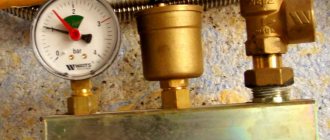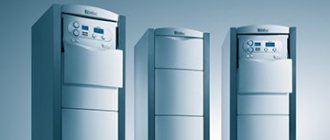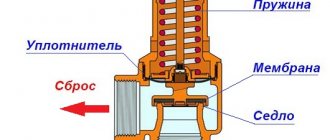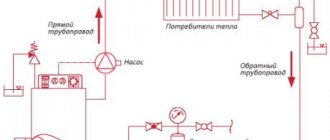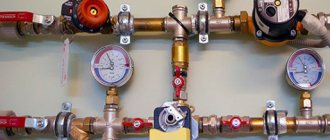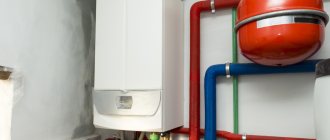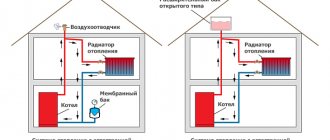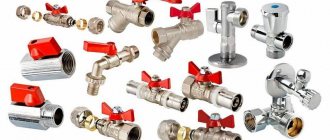Open
An open heating system must include an open expansion tank (tank). The highest part of the system is chosen as the location for its installation. This container functions as an expansion tank (compensating for excess expanding coolant when heated), an air vent and a safety valve. To ensure air removal through the expansion tank, the filling tank must be mounted at a stable slope.
The operating pressure in the heating system at each section of the circuit corresponds to the hydrostatic pressure of the water column. At the bottom, the column limits the measurement point, and at the top, the coolant level in the expansion tank. The excess pressure parameter of the 1st meter of water column is 0.1 kgf/cm2. In order for the water column to rise 10 m, the pressure drop must correspond to one atmosphere.
Accident Prevention
Increased pressure can cause irreparable damage. To protect communications in closed systems, security groups must be installed.
The group includes:
- pressure gauge;
- automatic air vent;
- safety valve.
The pressure gauge is used to visually monitor the pressure in the system.
If the pump turns off, but the fuel continues to burn, a solid fuel boiler may explode
When air is released from the coolant, the air vent is activated. It is designed in such a way that only gases pass through; water will not leak out of the pipes.
For individual houses, a safety valve is selected that is set to operate at 3 Atm. With further increase, the coolant will flow out of the pipe. The excess goes through the hose into the sewer or can be collected in a special container. A similar valve is installed in modern gas and electric boilers.
A safety group must be installed in systems with solid fuel boilers or non-volatile gas boilers.
When the power is turned off, the circulation pump stops working, while the fuel continues to burn. The coolant, remaining in the boiler heat exchanger, heats up and boils. The pressure rises to critical values, an explosion occurs with the destruction of the boiler equipment.
The safety group is installed on the supply pipes at the exit from the boiler, and not on the return pipe, which does not heat above 50–60 °C.
Closed
To regulate the pressure inside a closed heating system of a fixed volume, the following is used:
- Pumping water
. To achieve this, the heating circuit is connected to the cold water supply system using a jumper. Using a tap, you can solve the problem of how to create pressure in the heating system of a private house, as well as fill the circuit that was emptied before carrying out repairs. - Membrane expansion tank
. A membrane tank is a steel container consisting of two halves. An elastic rubber membrane is used for separation. The operating state is characterized by the presence of air with excess pressure in one of the halves (it is also called charging pressure). The other half of the tank contains coolant. The task of the tank is the same as in an open system: to compensate for the pressure of water in the heating boiler when it is heated. Air differs from liquid in that it is easy to compress, which is why the rate of pressure increase in the circuit is an order of magnitude lower.
Along with the main function, with the help of a container it is possible to smooth out pressure differences within a closed circuit. This refers to water hammer, which is caused by a sudden stop in circulation. As for the operating pressure indicators, when the boiler is turned off, it corresponds to the factory tank charging pressure specified in the instructions (1.5 kgf/cm2). The upper permissible point is 2.5 kgf/cm2. The safety valve is usually set to operate when 2.5 atm is reached.
A little theory
In order to clearly understand what the working pressure is in the heating system of a private house or high-rise building and what it consists of, we will provide some theoretical information. So, the working (total) pressure is the sum:
- static (gauge) coolant pressure;
- dynamic pressure causing its movement.
Static pressure refers to the pressure of the water column and the expansion of water as a result of its heating. If a heating system with a highest point at a level of 5 m is filled with coolant, then at the lowest point a pressure of 0.5 Bar (5 m of water column) will arise. As a rule, heating equipment is located below, that is, a boiler, whose water jacket takes on this load. An exception is the water pressure in the heating system of an apartment building with a boiler room located on the roof; here the lowest part of the pipeline network bears the greatest load.
Now let’s heat the coolant, which is at rest. Depending on the heating temperature, the volume of water will increase in accordance with the table:
When the heating system is open, some of the liquid will flow freely into the atmospheric expansion tank and there will be no increase in pressure in the network. With a closed circuit, the membrane container will also accept part of the coolant, but the pressure in the pipes will increase. The highest pressure will arise if a circulation pump is used in the network, then the dynamic pressure developed by the unit will be added to the static pressure. The energy of this pressure is spent on forcing water to circulate and overcoming friction against the pipe walls and local resistance.
Important. For setting and monitoring, pressure is always measured at the lowest point, near the boiler, where it is highest. It is for this purpose that pressure gauges are installed in the boiler room.
Central heating
In the private sector, autonomous heating is not always used. For example, in areas with harsh climatic conditions, heat for houses is supplied through taps from the heating main. To regulate heat transfer, the entrance to the home is equipped with an autonomous water-jet elevator, the basis of which is the recirculation of part of the coolant.
The working pressure in such cases has similar parameters to apartment buildings:
- On the supply pipe: 5-7 kgf/cm2.
- On the return pipe: 3-4 kgf/cm2.
- After passing through the elevator: 0.1-0.2 kgf/cm2 more than in the return.
Pressure increase due to expansion tank
Reasons for increased pressure in the heating circuit due to problems with the expansion tank:
- Small expansion tank volume. When heated to 85-90 °C, water adds about 4% in volume. If a small tank is selected, the coolant expands when heated and fills the container. There is a complete release of air through the valve. With further heating, the tank can no longer compensate for the thermal increase in the volume of water, as a result, the pressure in the system rises. The volume of the expansion tank must be at least 10% of the total coolant volume in the circuit if a gas boiler is installed, and at least 20% if the boiler is solid fuel. The volume of the tank can be taken approximately according to the boiler power: for 1 kW there are approximately 15 liters of water. But it is better to calculate the volume of a separate circuit (based on heating surfaces);
- Damage to the rubber membrane of the tank. In this case, the water will completely fill the container, and the pressure gauge will show a drop in pressure in the system. But, if you open the make-up valve and add water, then when the coolant heats up, the pressure in the heating circuit will become significantly higher than the operating one. To solve the problem, you will need to replace the tank if the membrane is diaphragm type, or replace the membrane if it is balloon type;
- The pressure in the expansion tank is too high or too low. Malfunctions in the expansion tank are one of the main reasons for increased pressure in a closed system. You can check the pressure and pump it up if necessary using an ordinary car pump. Before checking, you need to drain the water from the heating system - the needle on the system pressure gauge should be at zero. If there are shut-off valves and a drain on the water pipeline to the expansion tank, then it is enough to drain the water only from the tank. Then air is released through the nipple, which is located on the side opposite to the water supply. If the boiler operates at a pressure of 2 bar, then the pressure gauge on the pump should show 1.6 bar. You need to open the water shut-off valve and add the volume of water drained from the expansion tank through the make-up tap. This adjustment method works for both tanks with bottom and top water supply;
- The tank is located immediately after the circulation pump. This leads to the fact that the pressure rises sharply, and almost immediately it is released, and pressure surges are observed. This situation can provoke hydraulic shocks in the circuit. To solve this problem in a closed heating circuit, the expansion tank is installed on the return pipe - in a laminar flow zone with a minimum coolant temperature. The pump crashes into the return line after the tank, in front of the boiler.
Restrictions
All modern pipes and heating radiators have a declared operating pressure in the heating boiler of 6 atm. The reason why the autonomous heating parameters are not raised to at least 5 bar has its own explanations.
Reasons why pressure in the heating system affects:
- If you increase the pressure in the circuit, it will not bring any dividends. The height of the water column is used only when filling an empty system. A simple calculation shows that if the excess pressure is 1.5 atm, this will provoke a rise in water by 15 m. Considering the legal restrictions on the height of private buildings (three floors), this is more than enough.
- Unforeseen situations (water hammer or pressure surges due to a broken safety valve). The safety margin of batteries and pipes in such situations allows you to avoid serious accidents.
- You need to understand that the strength and service life of pipes indicated by the manufacturer does not always correspond to reality. First of all, we mean plastic products popular in private construction. In elevated temperature mode, a decrease in the declared characteristics is observed.
Only room temperature allows PN25 polypropylene pipes to accurately confirm the declared 25 atm. and service life of 50 years. If you increase the temperature to 90 degrees, the operating pressure in a closed heating system jumps to 7-9 atm. may cause destruction of the pipeline. This does not always lead to serious leaks, but this point must be taken into account.
Pressure in the system of a multi-storey building
Systems in high-rise buildings are characterized by high static coolant pressure. It increases with the height of the house, as the column of water in the pipes becomes higher. Accordingly, to overcome it, powerful pumps with a dry rotor are used. For example, the pressure in the heating system of a multi-storey building, whose diagram is shown below, must be at least 5 Bar.
It will take about 3 Bar to overcome the rise and about 2 more Bar with a reserve for friction with local resistance. On pressure gauges installed in basement heating units of high-rise buildings, you can see values from 4 to 7 bar. In general, in a central heating system, or more precisely, in the supply line, a pressure of 12-15 bar is often maintained. It all depends on the length of the route to the nearest thermal power plant.
Conclusion. With centralized heat supply in an apartment, measuring, much less trying to reduce, the maximum pressure in the system is pointless. Even if you take the readings of the pressure gauge at the heating point, it will not give anything; in apartments at different heights they will still differ. All that an apartment owner can worry about is the efficiency and service life of the radiators. It is better not to install cast iron batteries in high-rise buildings; they can only withstand about 6 bar.
Increase in pressure
The reasons for a spontaneous increase in pressure in the heating circuit, leading to the activation of the safety valve, may be as follows:
- Damage to the valve on the jumper with the cold water supply system. Screw valves and plug valves have one common problem - they are not able to provide absolute tightness when closed tightly. Gaps usually occur due to wear of the screw valve gaskets or scale trapped between it and the seat. This can also cause scratches on the faucet body and plug. When the pressure in a closed heating system exceeds a cold one (this happens very often), water gradually leaks into the circuit. It is subsequently discharged into the drainage through a safety valve.
- There is not enough expansion tank volume. The heating of the coolant and the subsequent increase in its volume cannot be fully compensated due to lack of space in the tank. Signs of this problem are an increase in pressure immediately when lighting or turning on the boiler.
To eliminate the first malfunction, it is better to replace the valve with a modern ball valve. This type of shut-off valve is characterized by stable tightness in the closed position and a huge service life. Frequent maintenance is also not required here. This usually comes down to tightening the gland nut under the handle after several hundred closing cycles.
To solve the second problem, you will have to replace the expansion tank by choosing a more capacious tank. There is also an option to equip the circuit with an additional expansion tank. In order for the system to operate without failures, the volume of the expansion tank should be approximately 1/10 of the total amount of coolant.
Sometimes it happens that an increase in pressure provokes the circulation pump. This is typical for the filling section after the impeller if the pipeline has high hydraulic resistance. The usual reason is undersized diameter. There is no need to panic in such a situation: this problem can be solved by simply installing a safety group (at a sufficient distance from the pump). Replacing the filling with a pipe of larger diameter is justified only if there is a large temperature difference between the first radiators from the boiler and the last ones in the direction of coolant circulation.
Pressure in a closed heating system
The circulation pump creates increased pressure in the section of the pipeline located behind it, thereby providing a number of advantages:
- The maximum length of the circuit becomes virtually unlimited (for a circuit with natural circulation - no more than 30 m). You just need to select a pump with sufficient power and devices with sufficient strength (in the area with the highest pressure).
- Smaller diameter pipes can be used.
- Radiators can be connected in series (single-pipe circuit).
- If the radiators are connected in parallel (two-pipe circuit), then with a circulation pump the heat distribution in the circuit will be more uniform.
- Since the coolant moves faster, it does not have time to cool down much, which means the boiler operates in a gentle mode.
- A system equipped with a circulation pump can be operated in low temperature mode, which may be required during the off-season. In a thermosiphon system, under such conditions, the convective flow will not be powerful enough to push the coolant through all the pipes and radiators.
The pressure developed by the circulation pump is called dynamic.
Closed heating system
Obviously, it must meet two requirements:
- Be no more than the value specified in the instructions for the boiler and other devices.
- Have power sufficient to overcome the hydraulic resistance of the heating circuit, which depends on its duration, configuration (single-pipe with series connection of radiators or two-pipe with parallel), pipe diameters and coolant movement speed. The user does not need to make complex calculations linking all these parameters. He just needs to adjust the pump power so that the temperature difference between the supply and return is not too large - usually 20 degrees.
In private homes, circulation pumps usually develop such a pressure that, combined with the static pressure (which does not go away), it amounts to 1.5 - 2.5 atm. As you move away from the pump, the dynamic pressure, “eaten up” by the hydraulic resistance of the circuit, gradually drops, while remaining quite high.
Under such conditions, the open-type expansion tank would have to be raised too high - about 10 m per atmosphere - otherwise the coolant would splash out of it. Therefore, instead of an open one, a sealed membrane expansion tank with an air cushion is used, and because of this the system is called closed.
While in private houses a mixing unit is used, a similar function in a centralized system is performed by the elevator unit of the heating system. We will analyze the principle of operation and connection diagram in the article.
See the list of necessary tools and the procedure for performing work on installing the heating system here.
Reducing pressure in the heating system of a private house
A decrease in pressure in a cold heating system (in the intervals between turning on/on the boiler) is normal. Usually, after heating the coolant, all parameters return to normal. This happens in any closed system. The negative consequences of a decrease in pressure is the formation of air pockets in the circuit, which impedes the circulation of the coolant.
At a stable temperature, pressure may drop for the following reasons:
- Some threaded or fitting connection of the circuit is leaking (this usually happens on an American radiator). A leak is usually indicated by a puddle on the floor. To fix it, you need to rewind the thread, tighten or change the fitting and sealing gasket.
- A fistula appeared on the heat exchanger in the heating boiler. To detect it, a visual inspection of the firebox or the opened body of a previously stopped boiler is carried out. The nature of the damage may require welding or replacement of the heat exchanger.
- The membrane of the expansion tank has torn or cracks have appeared on it. If the membrane tank is installed correctly (the line should point upward), air will be displaced into the system, followed by bleeding through an automatic air vent. When filling a larger volume with coolant, the pressure will definitely drop. The membrane or container needs to be replaced.
- The spool on the tank passes through which the container is pumped with air. Usually it is necessary to change the nipple tube or the entire spool.
- The air vent is poisoning. The systems can use automatic devices or Mayevsky cranes. If there are air pockets, water may not flow out. Such a gap is often detected by ear: it is indicated by a quiet hiss of air. There is also an option with alternate replacement of air vents.
- The seal between the radiator sections is leaking. A leak is indicated by a rusty mark on the battery. To solve the problem yourself, you will need a radiator wrench and two new seals. The battery needs to be unscrewed in the problem area, new gaskets installed and tightened again.
To solve the problem of how to increase the pressure in the heating system after completing repairs, open the tap on the jumper with cold water and fill the circuit. A pressure gauge is used to control the process.
Closed systems
These are systems in which the liquid does not come into contact with air outside the system.
They have a pump for forced water circulation and an expansion tank with a membrane. We have already written in more detail about the heating system with pump circulation here. The tank is a sealed container, which is internally divided into two parts by a rubber membrane. In its lower part there is a coolant, and in the upper part there is air under a pressure of one and a half atmospheres. It presses on the membrane, as a result of which a constant pressure of 1.5 atm is established in the system. We'll tell you how to fill a closed heating system without errors. It is better for two people to do the job. One will fill the water, and the second will monitor the drainage of air from the pipes. But if this is not possible, you can simply turn on the water under low pressure. The pipes in this system have a slight upward slope from the boiler to the top point. At this point, a valve is installed through which air is released. Before filling a closed heating system with water, the valve should be opened and a basin should be placed under it.
Next, the pipes should have a slight slope down to the lowest point. A tap is installed at this location to remove water from the system. There is also a pipe for pumping water into it (usually located just below the boiler). It is equipped with a check valve that allows water to flow in, but prevents it from flowing out. If a water pipe with a tap is connected to the pipe, you should simply open it. If there is no such line, another way to fill the heating system is suitable: using a flexible hose. It must be connected to the water supply system (for example, to a regular faucet in the kitchen) and to the pipe. The pressure in the water supply system should be slightly higher than the pressure of the heating system. When the pipes and heating radiators are filled with coolant, and water begins to flow from the valve at the top of the system, it should be closed. Then you need to bleed the air from the batteries (using Mayevsky taps). The water is shut off when, after complete deflation of air, its pressure on the pressure gauge built into the boiler reaches one and a half atmospheres (or more if the boiler passport provides for higher pressure in the system). In double-circuit boilers there is a module for feeding water to the heating system. It contains a tap for pumping water. Therefore, there will be no problems with how to fill the heating system of a double-circuit boiler, because it is easy to do. Just open the tap (at the bottom of the boiler). Through it, the heating system of the house will be filled with water. Although modern boilers are equipped with automatic air venting systems, they do not remove all air from the system. Therefore, installing the valve at its highest point is mandatory.
When starting a gas boiler, another important procedure is performed. Remove the front cover from the boiler and find a cylindrical circulation pump, which has a removable cover in the middle. Turn on the boiler and set it to operating temperature. The pump begins to gurgle due to the presence of air. It needs to be eliminated. To do this, slightly (not completely) unscrew the lid using a screwdriver until water starts dripping from inside. As soon as this happens, screw it back. Wait 2-3 minutes and repeat the procedure a couple more times. When the operation of the device becomes quiet, the electric ignition will turn on. The boiler will start supplying heat in operating mode. Once again they look at the pressure in the system, and if necessary, briefly open the feed tap.
This completes the filling of the closed heating system with water, and all that remains is to carry out additional debugging. It lies in the fact that with the help of control valves on the radiator pipes you can slightly tighten the heat supply to the batteries, which are located near the boiler, and increase its supply to distant radiators. Now there will be no problem with how to properly fill a closed heating system with water, and you can do this work yourself quickly and efficiently.
What indicators are considered normal?
The standard for autonomous systems of private houses is 1.5-2 atmospheres. More than this is already a critical indicator. A pressure in the heating system of 3 atmospheres will lead to an accident: the heating structure may depressurize, the equipment will fail.
Multi-storey buildings in our country are heated using a closed circuit and forced supply of energy. If the operating conditions of the system are ideal, then the pressure in it is about 8-9 atmospheres. But in old weak houses there may be a loss of pressure, which leads to its reduction to 5 atmospheres.
Expansion tanks maintain the pressure and do not allow it to increase too much. Their work begins at a pressure of 2 atmospheres.
The tanks remove excess liquid from the pipeline, thereby normalizing the pressure. If the volume of these containers is not enough, then it rises to 3 atmospheres. To reduce this critical threshold, special valves are used.
In a multi-storey building, pressure regulators are installed at the lower levels and pumping equipment at the upper levels (to increase the pressure).
